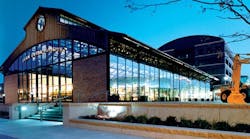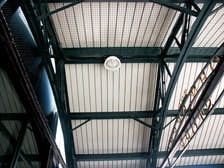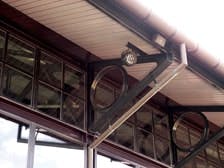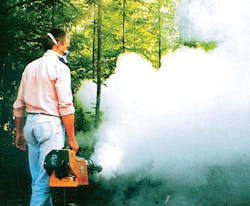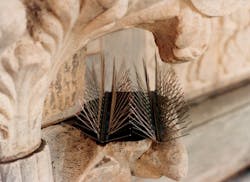Bird droppings can destroy almost any building material, including wood, stone, marble, steel, and iron. The accumulated droppings can also damage roofs, clog gutters, discolor paint, corrode I-beams, ruin cloth awnings, and short out electrical equipment.
An important consideration in the building process should involve how to prevent birds from roosting on the structure. Installing bird deterrents at the outset of a project (rather than retrofitting) saves time and money, and eliminates the dangers of bird-borne diseases, material degradation, and the unsightly mess of bird droppings. The time and effort required to remove bird waste, along with the dangers associated with handling it, makes front-end installation preferable.
Research has found more than 60 transmittable bird-borne diseases and dangerous parasitic organisms that can be fatal to some people and cause others to fall ill. When dried-out bird droppings are disturbed, a cloud of airborne dust carries micro-organisms into the lungs, causing inhalation diseases, such as histoplasmosis. Eating or drinking foods that have come into contact with bird-related bacteria can cause ingestion diseases, such as toxoplasmosis and query fever.
One of the most common bird-roosting deterrents—bird-control strips, commonly referred to as "porcupine wire" or "bird spikes"—is relatively inexpensive and easy to install, and eliminates the ugly mess and deterioration that roosting birds can bring. This simple, effective bird-control device dates back to 1950, when newly invented porcupine-wire strips were installed on the structures of President Dwight D. Eisenhower's farm near Gettysburg, PA. According to the farm's maintenance supervisor, the original installation is still in place and hasn't required maintenance in the 50-plus years that have passed since the initial installation.
Aesthetics is another benefit of porcupine wire strips. The thin, stainless-steel wires are invisible at the distances from which structures are usually viewed. The patina of weathering quickly makes installations unobtrusive, even up close. This feature has made porcupine wire the system of choice for many well-known landmarks and historical restorations. Some manufacturers of porcupine wire offer custom color coat over the stainless-steel spikes, ensuring that they become part of the architectural design.
Specifiers must choose a deterrent that will repel birds of all shapes and sizes. Some bird strips on the market only keep large birds away and are only for light infestation problems. Many porcupine-wire products have large gaps between the wires, allowing small birds to sit or nest in between them. To avoid this situation, it's very important to choose a product that has 120 points per foot, composed of 100-percent stainless steel. The points must be strategically configured close together, pointing in all directions. Some deterrents come in different sizes to accommodate different surface depths; you may have to run multiple rows to cover large surfaces. It's critical to protect the entire surface area and follow the manufacturer's directions and specifications very carefully.
Here are some tips on processes and other products to help rid your facility of roosting birds ...
Identify the problem.
Before purchasing a bird-control system, identify the types and number of birds causing the problem. Make note of the areas where birds are landing and roosting. If the birds are not present at the time of inspection, look for nests and droppings on the building, sidewalks, awnings, signs, etc. Look for nearby water and/or food sources; if possible, eliminate them.
Research available bird-control products.
There are many different products on the market that claim to be effective bird barriers, but you should spend time researching the facts. First, look for a reputable company with a proven track record. Next, call the company, explain your problem, and ask for advice. A reliable company will offer free technical support, including drawings and installation plans for your particular job. Some jobs may require more than one product to effectively repel birds.
Don't buy a product based on price alone: There are many factors to consider, such as maintenance costs, the product's lifespan, and installation costs. Some of the non-lethal products available today:
-
Bird netting. Netting is a good choice for access control. If you have an open warehouse, a building, or an overhang where birds get up into the rafters and beams, bird netting is an effective, economical choice. Netting should be strong and lightweight, with 0.75-inch square openings or smaller. Larger openings may not prevent smaller birds (like sparrows) from getting through. Make sure the netting is a dark color and ultraviolet stabilized to reduce deterioration from exposure to the elements. There are different ways of installing bird netting; some may be very simple while others may require an experienced contractor. Bird netting can be used for other applications, like netting off decorative columns and ledges, but doing so may hamper aesthetics - the netting can be highly visible.
-
Safe chemical bird repellents. Look for safe chemical bird repellents that are regulated by the U.S. EPA (Environmental Protection Agency) under FIFRA (the Federal Insecticide, Fungicide, and Rodenticide Act). In many instances, fogging may be used indoors and outdoors to repel any nuisance birds, such as Canada geese, pigeons, starlings, blackbirds, cowbirds, gulls, mallards, and other birds that have become a nuisance or a health hazard. When a bird is exposed to a safe fogging bird repellent, the result is a temporary pain stimulus that irritates a nerve in the bird's mucus membrane. (This causes no permanent damage to birds, but they will associate the pain stimulus with the site and learn that the area is not desirable.) Another safe chemical repellent (a micro-encapsulated product that can be mixed with water and sprayed on turf to control damage caused by geese, ducks, and birds) makes turf unpalatable, forcing birds to feed elsewhere.
-
Sticky paste and liquid repellents. These types of products work by spreading a non-drying, nontoxic, sticky substance on the surface to be protected. The compound tends to irritate birds' feet upon landing so that they leave the protected area. Many brands of sticky repellents are available; as with all products, follow the manufacturer's directions closely, particularly with respect to application, long-term maintenance, etc.
-
Pin and wire. Pin and wire systems have been used for many years with varying degrees of success. As another form of mechanical barrier, pin and wire systems work on the theory that birds will not land where tight strands of wire cover the surface. This type of system can be very labor intensive. Pin and wire barriers generally blend in well, but should only be used for repelling large birds in very light-pressure areas. In heavy-infestation situations, birds can roost and build nests in the wires. These systems work best when covering very narrow surfaces, such as railings, along balconies, and where there is moderate human activity. Some systems can now transmit a low-voltage current through the wires to help repel bird. While effective, this type of system can be more expensive and maintenance intensive. In addition, electric wires may present a fire hazard if not installed correctly.
-
Scare-away devices. Of the various scare-away devices available, balloons seem to work better because they move around with the wind. You may find it helpful to frequently change balloon position and color to help prevent birds from getting used to them.
Plan the installation.
After you have chosen the most effective product or combination of products, you must decide if you want to install it yourself or have a qualified contractor do the job. Either way, make sure that all areas have been carefully measured so you order the correct amount of materials. Before installing any system, clean the entire area thoroughly (see Getting Ready for Installation) and remove dirt, nests, and bird droppings. Most importantly, follow all of the manufacturer's directions and recommendations. This way, you won't have the expense of doing the job again. Picking the right product, following directions, and a little common sense are all it takes to do the job successfully.
Cory Gellerstedt is co-president at East Moline, IL-based Nixalite of America Inc., and can be reached at [email protected] or (800) 624-1189. He has 20 years of experience in the bird-control industry and is a member of the National Pest Management Association (NPMA).
